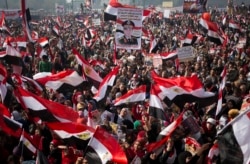Recent protests around the world have brought renewed attention to demonstrations as a form of expression and call for change.
The year 2019 saw protests in Hong Kong, Lebanon, Gaza, France, Venezuela and other places. Worldwide, protesting slowed in early 2020 because of the spread of the new coronavirus.
That changed after the death of George Floyd.
Demonstrations around the world were held in support of Americans protesting the death of Floyd, a black man who died after a white police officer kneeled on his neck for several minutes.
In cities across the U.S., some protests turned violent, as people expressed their anger over the incident and their strong desire for change.
Historically, however, huge demonstrations rarely bring about results expected by those who take part in them.
The Associated Press recently looked back at some important protests from the past.
American civil rights
The AP says the recent protests in the United States are unusual because they have been largely leaderless. It notes that, while the protests are still evolving, the main issue has been the Black Lives Matter movement. Recent protests have invited comparison to the civil rights protests of the 1950s and 1960s in the United States.
In 1963, Martin Luther King, Jr. led a march of 250,000 people to Washington, D.C. King and activist Malcolm X represented two different plans for protests. One supported large, peaceful demonstrations. The other wanted to get results “by any means necessary.”
During that period, major civil rights acts and the Voting Rights Act were passed under the administration of President Lyndon Johnson. But protests against social injustice and the Vietnam War continued into the 1970s, often becoming destructive and violent.
Democratic Party lawmakers this month proposed new measures to control local police departments in the United States. But the Democratic Party's presidential nominee, Joe Biden, has not supported recent calls by protesters across the country to “defund the police.”
President Donald Trump and his Republican allies have strongly criticized calls for defunding police departments.
The fall of the Soviet Union
In 1989 in Eastern Europe, protests were increasingly against rule by the Communist Party. One by one, countries like the former East Germany and Poland cut off influence of the former Soviet Union. The final Soviet leader, Mikhail Gorbachev, permitted the change to take place. The end of one-party rule in East Germany and Poland was largely peaceful.
The time period also included the “Velvet Revolution” which brought the end of Soviet influence in the former Czechoslovakia. The change took place about 20 years after similar protests against the Soviet Union in 1968 were crushed by hundreds of thousands of Soviet-led troops.
The Arab spring of 2011
More than 20 years later, a major wave of political protests overtook the Middle East and North Africa. The demonstrations were captured on social media. The movement, known as the Arab Spring, gave voice to people who demanded change in their governments.
In Egypt, Yemen, Libya and Tunisia, long-time rulers fell in 2011. But only in Tunisia has democracy lasted.
Since 2011, Egypt’s authoritarian rule has increased. Yemen and Libya continue to be involved in civil wars that have created humanitarian crises. Syria was also influenced by the Arab spring movement. But the civil war that soon followed continues today, with an estimated 500,000 dead and millions displaced.
More recently, protests in Lebanon and Iraq started last October against leaders considered corrupt and ineffective. But Lebanon has not been able to solve its political problems and faces a severe financial crisis.
In Iraq, many protesters have been killed and the country’s health care system remains unable to deal with the effects of the new coronavirus. In addition, money from the sale of oil has fallen sharply because of low oil prices.
2019 and 2020
Last year, huge protests against the rule of longtime Sudanese President Omar al-Bashir led to his ouster by the army in April 2019. Bashir now faces charges of genocide and war crimes. He has been replaced by a joint civilian-military “sovereign council.” But civilians struggle to assert control over important government ministries.
Huge protests in Hong Kong renewed one year ago. People gathered in support of democracy and against a proposed law that would send some Hong Kongers accused of crimes to mainland China for trial. The protests were met with harsh police action, but succeeded in forcing the withdrawal of the law.
However, Chinese President Xi Jinping has not backed down. Last month, China’s National People’s Congress approved a new national security law for the partly self-ruling territory.
The new law requires Hong Kong to enforce measures that will be decided by a top committee in Beijing. The law also permits Chinese intelligence agencies to operate in the city.
Britain handed Hong Kong over to China in 1997 after years of negotiations. The two sides agreed that the territory’s laws, known as the Basic Law, would remain in place until 2047.
But recent moves by the mainland government have raised questions about how long Hong Kong’s self-rule may last.
I’m Mario Ritter Jr.
And I'm Ashley Thompson.
Tamer Kakahany reported this story for the Associated Press. Mario Ritter Jr. adapted it for VOA Learning English. Ashley Thompson was the editor.
Editors note: the description of the protest movement in this story has been updated.
______________________________________________
Words in This Story
authoritarian –adj. a form of government marked by not permitting personal freedoms
assert –v. to demand that other people accept something
harsh –adj. severe, having a harmful effect because of too much force
evolving --v. to change over time, to develop further














